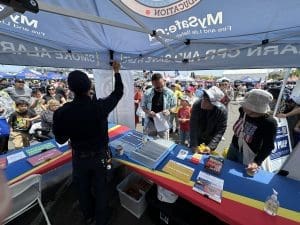In 2014, nine people died in house fires in the City of Los Angeles in just the first 90 days of the year. Interim LAFD Fire Chief James Featherstone and MySafe:LA Executive Director David Barrett collaborated on the development of a plan to engage residents in the immediate area surrounding fatal fires. Called “Smoke Alarm Field Education,” or SAFE, MySafe:LA would be deployed to any fatal incident, and notify residents about the fire, install FREE smoke alarms, and provide fire safety education to improve resilience in the community.
It has been a decade since this initiative commenced, and MySafe:LA has installed tens of thousands of smoke alarms into homes throughout L.A. County. The good news is that the number of annual fatalities in Los Angeles has declined by more than 30% since this program was commenced. The challenge is that every death has an impact on the community.

The death of a community member in a house fire can have profound and lasting impacts on a neighborhood or community, particularly in a densely populated and diverse area like Los Angeles. Here are some of the significant effects that such a tragic event can have:
- Emotional Impact: The immediate and most palpable impact is emotional. Grief and shock can permeate a community, especially if the individual was well-known or active in local activities. The psychological toll can affect not only the family and friends of the deceased but also neighbors and first responders who might feel a deep sense of loss and trauma.
- Sense of Vulnerability: A fatal fire can heighten feelings of vulnerability and fear among community members. People may begin to worry more about their own safety and the safety of their families, particularly regarding the adequacy of their fire prevention and preparedness measures.
- Community Cohesion: In response to such a tragedy, communities often come together to support the bereaved family and each other. This can lead to stronger bonds and a more cohesive community as people unite to provide emotional support, organize memorials, and possibly engage in fundraising activities to help those affected.
- Awareness and Prevention Efforts: A fatal house fire can serve as a catalyst for increased community awareness about fire safety. Local fire departments and community leaders may organize workshops, safety checks, and distribute information on fire prevention techniques to prevent future incidents.
- Policy and Regulatory Scrutiny: Depending on the circumstances surrounding the fire, there might be an investigation that could lead to a reevaluation of building codes, safety regulations, and emergency response protocols. This can lead to changes designed to enhance community safety and reduce the risk of similar incidents in the future.
- Economic Impact: The destruction of property and potential loss of income for the victim’s family can have ripple effects in the local economy. There may also be increased insurance premiums for the community if the area is deemed to be at higher risk.
- Impact on First Responders: Firefighters and emergency medical teams who respond to fatal fires can experience significant emotional and psychological stress, particularly if they are unable to save the occupant(s) of the home. This can lead to increased stress, burnout, and in some cases, post-traumatic stress disorder (PTSD).

The community’s response to such tragedies can greatly influence the healing process and the implementation of measures to prevent future occurrences. The Safe Community Project will continue to work with community leaders, local authorities, and residents to navigate the aftermath of such events and to bolster community resilience and safety.








